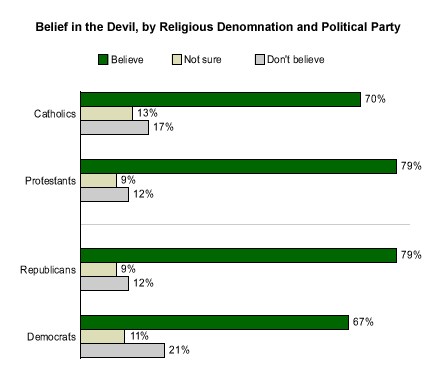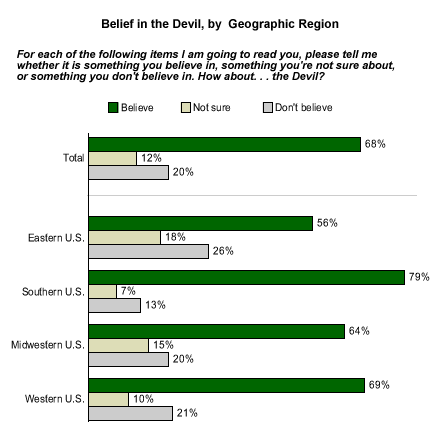The devil has received a great deal of publicity through the centuries, though his personal characteristics have varied tremendously. John Milton imagined Satan as a cunning and "magnificent" fallen angel. The American Puritans thought of the devil as a cloven-hoofed beast and dance-leader of witches. Robert Johnson told his friends the devil was an excellent guitar player. The Rolling Stones' Lucifer was "a man of wealth and taste."
More recently, Gallup asked Americans if the devil is something they believe in, something they're not sure about, or something they don't believe in. Sixty-eight percent said in a May 2001* poll that they believe in the devil, 20% said they don't, and 12% said they aren't sure. Majorities of Americans of every political inclination, region, educational level, and age group said they believe in the devil.
Devil Inside Religion and Politics
Naturally, people who tend toward religiosity are more likely to believe in the devil. Eighty-three percent of Americans who said religion is "very" important in their lives believe in the devil, but the number drops to 62% among those for whom religion is "fairly" important. Only 22% of those who said religion is "not very" important said they believe in the devil. In fact, this is the only subgroup in which those who believe in the devil are in the minority.
Eighty-three percent of self-described members of the religious right believe in the devil, as do 64% who don't consider themselves members of the religious right. Seventy-nine percent of Protestants and 70% of Catholics believe in the devil.
Democrats (67%) and independents (59%) are both less likely than Republicans (79%) to have said they believe in the devil. Political ideology follows a similar pattern: 75% of conservatives, 70% of moderates, and 52% of liberals believe in the devil. Previous Gallup analyses show a wide gulf between conservatives and liberals (and by extension, Republicans and Democrats) in religiosity.

The Devil Went Down to Georgia, and Visited Elsewhere
There is some variation in belief in the devil by geographical region, just as Gallup data show differences in religiosity by region. Southerners (79%) are more likely than Midwesterners (64%) and Easterners (56%) to say they believe, with Westerners appearing to fall somewhere in between (69%). There is also a difference between the town and country sets: 66% of urbanites and 64% of suburbanites say they believe in the devil, but there is greater belief among people in the rural communities (78%).

Fiend for All Ages
Though Gallup polling has shown that religiosity tends to be greatest among the oldest age groups, belief in the devil doesn't seem to be. Sixty-six percent of people between the ages of 18 and 29 said they believe in the devil, as did 70% of those between 30 and 64 and 65% of people 65 and older.
Nor does higher education appear to quash belief in the devil. While Americans with postgraduate degrees are less likely to believe in the devil (55%) than college graduates (68%) and those whose education doesn't extend past high school (70%), a majority of postgrads still believe in the devil.
Bottom Line
Over the centuries, science has been able to explain many phenomena that once seemed supernatural. Bad weather, ill health, and heretical opinions may not be the work of the infernal after all. With the advent of evolutionary theory and modern psychology, these days we're more likely to think of people who do terrible things as broken human beings, rather than agents of the netherworld. Furthermore, religion has ceded its civil authority, and religiosity has declined somewhat in American society. So we might expect belief in the devil to have largely evaporated. It hasn't. Regardless of political belief, religious inclination, education, or region, most Americans believe that the devil exists.
*Results based on telephone interviews with 1,012 adults, aged 18 and older, conducted May 10-14, 2001. For results based on the total sample of national adults, one can say with 95% confidence that the maximum margin of sampling error is ±3%.
